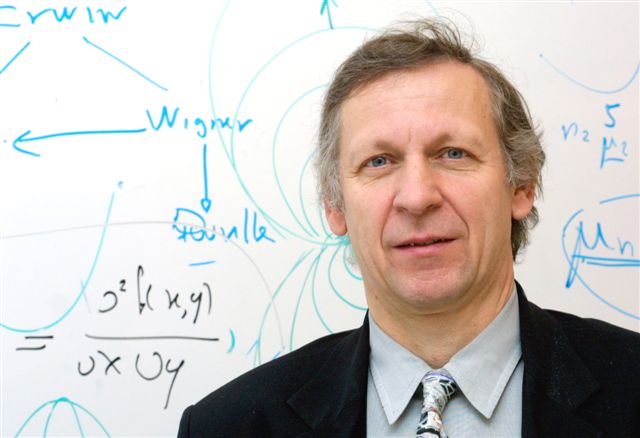| |
Distinguished scientists will speak at the conference
 |
RNDr. Jana Madejová, DrSc. - Slovak Academy of Science, Slovak Republic
Jana MadejovŠ, is world-renowned expert Infra-red spectroscopy in theory and clay minerals application.
Since 2009 she is holding position of president of Slovak clay group. She is senior researcher in Slovak Academy
of Science, Institute of Inorganic Chemistry. Dr.MadejovŠ wrote and co-authored more than publications ,
and her work was cited more tha 1750 times.She has been awarded for her work with price Premium of the Slovak
Literary Fund for citations in last three years.
|
Near-IR spectroscopy in the organo-clays studies
The potential of near infrared (NIR) spectroscopy in the investigation of organo-montmorillonites (OMMT), perspective fillers in clay polymer nanocomposites,
is introduced. Analysis of the NIR spectra of MMT saturates with different surfactants allows identification of specific bonds not-detectable in the traditionally
used middle IR region. The possibility to follow the effect of alkylammonium cation size on the extent of OMMT decomposition in HCl is presented. NIR spectroscopy shows
that the least stable are samples saturated with small cations while the most resistant to acid attack are OMMT with large cations.
 |
prof. Xiaofeng Xie - Tsinghua University in Beijing, China
An associate professor, with a Ph.D. in Chemical Engineering, at the Institute of Nuclear Energy Technology, Tsinghua University in Beijing, China. The current research interest
is in the field of proton exchange membrane for use in fuel cells and vanadium redox flow battery for large-scale energy storage. She completed and is taking a number
of national new energy projects.
|
Nano-oxide modified graphite felt for all vanadium flow redox battery
All vanadium flow redox battery (VFB) is a new type of energy storage batteries. It has the advantages of high-power, large current charge and discharge, and without geographical restrictions.
The graphite felt becomes one of the most extensive use of the VFB electrode materials due to itís the large specific surface area, acid and alkali resistance and good mechanical properties.
to that of untreated graphite felt. A large number of nano-oxide adsorbed on the graphite surface of the felt fiber, nano-bismuth oxide aggregate particle size and number are significantly
smaller than the indium oxide nanoparticles.
 |
prof. Ewa Mijowska - West Pomeranian University of Technology Szczecin, Poland
Prof. Ewa Mijowska (previously Borowiak-Palen) a group leader of research team on molecular
nanostructures for different applications within Department of Nanotechnology, Institute of Chemical and
Environmental Engineering, West Pomeranian University of Technology Szczecin, Poland. Author and co-author
of ~110 publications with IF, coordinator of several project related to the topic of interest. Research activity
focused on synthesis and characterization of different molecular nanostructures e.g. nanomedicine and nanoelectronics
|
Magnetic Silica Nanotubes - Synthesis, Drug Release, and Feasibility for Magnetic Hyperthermia
A new kind of silica nanotube with incorporated iron oxide nanoparticles has been successfully prepared through sol-gel processes.
Hematite particles supported on carbon nanotubes served as templates for the fabrication of the magnetic silica nanotubes. The hollow
inner space and the magnetic functionalization render the material promising for applications in biology and medicine. This is
underlined by studies in alternating magnetic fields which show a significant heating effect, i.e., the feasibility for applications in hyperthermia therapies.
In addition, the material exhibits enhanced drug-loading capacity which is demonstrated by loading with rhodamine B molecules as drugs and corresponding release experiments.
 |
Stuart Tessmer, Ph.D. - Michigan State University, U.S.A.
Stuart Tessmer earned his BS in Physics from the University of Washington, and his MS and PhD in Physics from the University of Illinois, Urbana-Champaign.
From 1996-1998, he worked as a Postdoctoral Fellow in the Raymond Ashoori lab at the Massachusetts Institute of Technology. Dr. Tessmer is currently an
Associate Professor of Physics at Michigan State University.
His research interests include nanoelectronics, semiconductor defects, superconductivity and biophysics.
|
Probing the quantum levels of individual semiconductor impurities
Elucidating the physics of these minute systems is a difficult technical challenge. We have developed a capacitance-based scanned-probe method that
can detect individual electrons entering impurities. Single-electron peaks have been observed in the capacitance-versus-voltage curves for both donors
and acceptors in silicon and gallium-arsenide materials. We find that the quantum states in these systems can be understood in terms of dopant molecules,
effectively formed by nearest-neighbor dopant pairs.
 |
prof. Hatem Akbulut -Sakarya University, Turkey
Hatem Akbulut is working as full professor in Sakarya University, Engineering Faculty, Department of Metallurgy and Materials Engineering.
He received his MSc and Ph.D. degrees in Metallurgical Engineering from Istanbul Technical University. He is the Head of Materials Division and project coordinator for
the Lithium-ion battery research, development and application center. His main research activities include, electrode development
for Li-ion batteries, metal matrix nanocomposites, surface modification of materials and characterization of surface layers, electrochemical characterization,
tribology of advanced materials and surface modified materials.
|
Advanced Nanocomposite Anode Preparation and Characterization For Li Batteries
Lithium batteries are most commonly employed as power sources for portable electronic devices. Limited capacity, high cost, and safety problems associated with the commercially used graphite anode
materials are hampering the use of lithium batteries in larger-scale applications such as the electric vehicle. Nanocomposites have shown promise as new anode materials because of their better safety
due to higher operating potential, increased energy density, low cost, and straightforward synthesis as compared to graphite.
Recent developments in the discovery of nanocomposite anode materials and their advanced characterization techniques for lithium batteries will be presented. The advantages and disadvantages of the nano-scale in composite
anode materials preparation and the new characterization methods are highlighted.
 |
prof. Michael Cada - Dalhousie University, Halifax, Canada
|
Single-Photon Nanophotonics
In conventional photonics, various functions such as switching or sensing are implemented with modern nanoscale technologies; however, the actual use of photons is still
far from the ultimate level of exploitation, i.e. at the quantum limit level whereby the underlying principle is to generate, detect and manipulate single photons. Some recent
proof-of-concept demonstrations have been promising including photonic quantum circuits on a silicon chip, high-efficiency photon-number-resolving detectors based on superconducting
nanowires, semiconductor-cavity-quantum-dot single-photon sources, photonic crystal quantum-dot-based single-photon nonlinearities, or photon-induced tunneling.
![Krzysztof Cendrowski]() |
dr.Krzysztof Cendrowski - West Pomeranian University of Technology Szczecin, Poland
Krzysztof Cendrowski is a group member of research team in Department of Nanotechnology, Institute of Chemical and Environmental Engineering, West Pomeranian University of Technology
Szczecin, Poland. His research is focused on molecular nanostructures for medical and environmental applications. He applies high resolution transmission electron microscope
and its modes and many other advanced techniques for study of the interaction between nanomaterials and bacteria/fungi/cells.
|
Single-Photon Nanophotonics
High resolution electron microscopy analysis is one of more important methods for detailed characterization of nanoparticles and nanocomposites.
The electron microscopy can be divide in to two main visualization technique: scanning (SEM) and transmission microscopy (TEM). Main differences
between the scanning and transmission microscopy is the obtained date on the morphology of studied materials and resolution of the image.
Transmission electron microscopy is more powerful device, capable in detailed morphology visualization at the molecular level. Due to the high
tension of the transmission microscopy obtained images clearly shows the inner structure of the nanomaterials like: core-shell structure, hollow space,
guest molecules in the composites or porous structure of the nanomaterials.
|